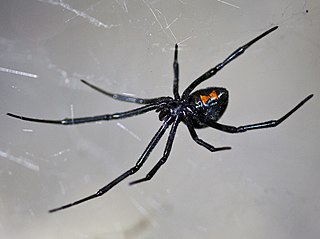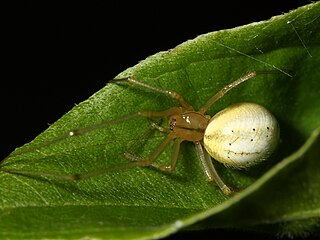
Latrodectus is a broadly distributed genus of spiders with several species that, together, are referred to as true widows. This group is composed of those often loosely called black widow spiders, brown widow spiders, and similar spiders. However, such general "common names" are of limited use as the diversity of species is much greater. A member of the family Theridiidae, this genus contains 32 species, which include several North American "black widows". In addition to these in North America are also the red widow Latrodectus bishopi and the brown widow Latrodectus geometricus, which, in addition to North America, has a much wider geographic distribution. Elsewhere, others include the European black widow, the Australian redback black widow, several different species in Southern Africa that can be called Button spiders, and the South American black widow spiders. Species vary widely in size. In most cases, the females are dark-coloured, but some may have lighter bodies or even reddish. Many can have red, white or brown markings on the upper-side (dorsal) of the abdomen. Some can be readily identifiable by reddish markings on the central underside (ventral) abdomen, which are often hourglass-shaped.

Theridiidae, also known as the tangle-web spiders, cobweb spiders and comb-footed spiders, is a large family of araneomorph spiders first described by Carl Jakob Sundevall in 1833. This diverse, globally distributed family includes over 3,000 species in 124 genera, and is the most common arthropod found in human dwellings throughout the world.
Paraheliophanus is a genus of Atlantic jumping spiders that was first described by D. J. Clark & P. L. G. Benoit in 1977. The name is a combination of the Ancient Greek "para" (παρά), meaning "alongside", and the salticid genus Heliophanus.

Wirada is a genus of comb-footed spiders that was first described by Eugen von Keyserling in 1886.

Theridula is a genus of cobweb spiders, found in many parts of the world. Species vary in size from 1 to 3.5 mm in length.

Rugathodes is a genus of comb-footed spiders that was first described by Allan Frost Archer in 1950. It is closely related to members of Theridion and Wamba.

Steatoda capensis is a spider originating from South Africa. Its common names include the black cobweb spider, brown house spider, cupboard spider and due to its similarities to the katipō spider it is commonly known as the false katipō in New Zealand. Common throughout Southern Africa, it has been introduced into other countries and is now present in Australia and throughout New Zealand. It is a small spider, usually an all-over shiny black it may have a small bright red, orange, or yellow patch near the tip of the abdomen along with a crescent shaped band near the front of the abdomen.
Andasta is a genus of ray spiders that was first described by Eugène Louis Simon in 1895.
Tecution is a genus of spiders from Saint Helena within the family Cheiracanthiidae. They were first described and named by Benoit in 1977. It was originally placed in the Clubionidae, but it was moved to Miturgidae in 1997, then to Cheiracanthiidae by Ramírez in 2014. The genus consists of three species.

Tylorida is a genus of long-jawed orb-weavers that was first described by Eugène Louis Simon in 1894.
Propostira is a genus of Asian comb-footed spiders that was first described by Eugène Louis Simon in 1894. As of June 2020 it contains two species, found in Sri Lanka and India: P. quadrangulata and P. ranii.
Helenactyna is a genus of cribellate araneomorph spiders in the family Dictynidae, and was first described by Pierre L.G. Benoit in 1977. As of May 2019 it contains only two species, both from Saint Helena: H. crucifera and H. vicina.
Napometa is a genus of Atlantic dwarf spiders that was first described by P. L. G. Benoit in 1977. As of May 2019 it contains only two species: N. sanctaehelenae and N. trifididens.
Pholcomma is a genus of comb-footed spiders that was first described by Tamerlan Thorell in 1869.
Ruborridion is a monotypic genus of Asian comb-footed spiders containing the single species, Ruborridion musivum. The species was first described under the name Theridion musivum in 1873. The genus was described by J. Wunderlich in 2011. They are found in India.
Sardinidion is a monotypic genus of comb-footed spiders containing the single species, Sardinidion blackwalli. It was first described by J. Wunderlich in 1995, and is found in Africa and Europe.

Simitidion is a genus of comb-footed spiders that was first described by J. Wunderlich in 1992. As of June 2020 it contains three species, found in Africa, Asia, Europe, and Canada: S. agaricographum, S. lacuna, and S. simile.
Spinembolia is a monotypic genus of African comb-footed spiders containing the single species, Spinembolia clabnum. It was first described by Michael I. Saaristo in 2006, and is found on the Seychelles.
Stoda is a monotypic genus of African comb-footed spiders containing the single species, Stoda libudum. It was first described by Michael I. Saaristo in 2006, and is found on the Seychelles.
Bonapruncinia is a monotypic genus of Atlantic crab spiders containing the single species, Bonapruncinia sanctaehelenae. It was first described by P. L. G. Benoit in 1977, and is found on Saint Helena.







